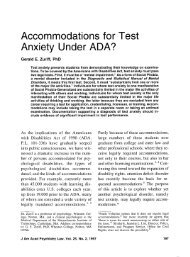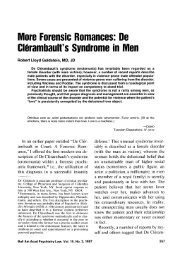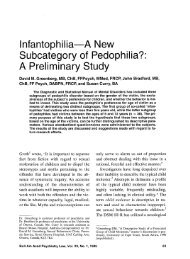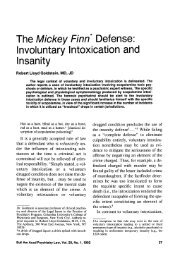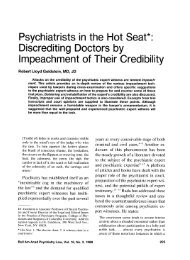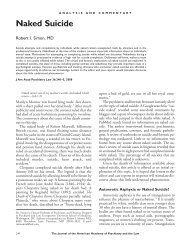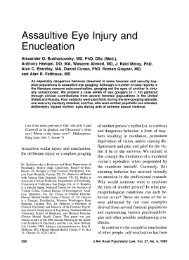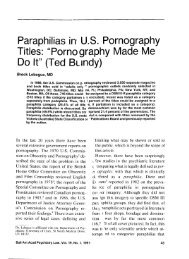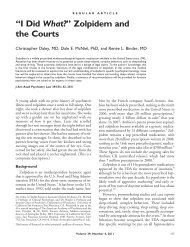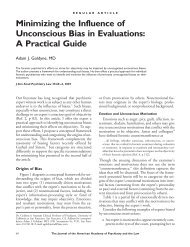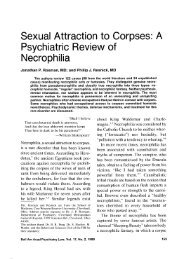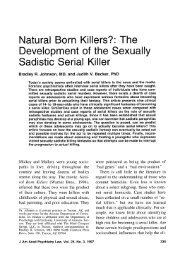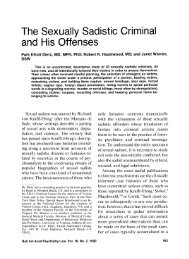Tarasoff at Twenty-Five - Journal of the American Academy of ...
Tarasoff at Twenty-Five - Journal of the American Academy of ...
Tarasoff at Twenty-Five - Journal of the American Academy of ...
You also want an ePaper? Increase the reach of your titles
YUMPU automatically turns print PDFs into web optimized ePapers that Google loves.
same time, it potentially expands <strong>Taras<strong>of</strong>f</strong> slightly, in<br />
th<strong>at</strong> it expressly requires notific<strong>at</strong>ion <strong>of</strong> both law enforcement<br />
and <strong>the</strong> victim (not just <strong>the</strong> victim, as<br />
<strong>Taras<strong>of</strong>f</strong> implied). Fur<strong>the</strong>r, it makes plain, notwithstanding<br />
<strong>the</strong> incant<strong>at</strong>ion “and protect,” th<strong>at</strong> <strong>the</strong> only<br />
duty is to warn: “. . . <strong>the</strong> duty shall be discharged by<br />
. . . reasonable efforts to communic<strong>at</strong>e <strong>the</strong> thre<strong>at</strong> to<br />
<strong>the</strong> victim ...andtoalawenforcement agency.” 13<br />
As in California, <strong>the</strong> basic duty-to-warn law currently<br />
in force in most <strong>of</strong> <strong>the</strong> jurisdictions th<strong>at</strong> have<br />
such a law is st<strong>at</strong>utory. This, however, does not end<br />
or neg<strong>at</strong>e <strong>the</strong> role <strong>of</strong> courts in sculpting such law.<br />
Again, California is illustr<strong>at</strong>ive. The California<br />
Court <strong>of</strong> Appeal was called on to apply th<strong>at</strong> st<strong>at</strong>e’s<br />
duty-to-warn st<strong>at</strong>ute (just quoted) in Barry v.<br />
Turek. 14 A brain-injured p<strong>at</strong>ient on a locked psychi<strong>at</strong>ric<br />
ward habitually engaged in grabbing and fondling<br />
improprieties toward female nurses and had to<br />
be continuously redirected from such activities.<br />
However, as <strong>the</strong> court makes clear, he “never made<br />
verbal thre<strong>at</strong>s <strong>of</strong> violence within <strong>the</strong> hearing <strong>of</strong> [defendant,<br />
<strong>the</strong> ward’s chief psychi<strong>at</strong>rist]”(Ref. 14, p<br />
554). Under <strong>the</strong> st<strong>at</strong>ute, <strong>the</strong> absence <strong>of</strong> an explicit<br />
thre<strong>at</strong> should seemingly end <strong>the</strong> case, as <strong>the</strong> court<br />
itself acknowledged (Ref. 14, p 554).<br />
Eventually, a hospital employee was assaulted<br />
more seriously than those in <strong>the</strong> previous incidents,<br />
and she sued <strong>the</strong> p<strong>at</strong>ient’s psychi<strong>at</strong>rist for failure to<br />
warn. Despite <strong>the</strong> st<strong>at</strong>ute’s clear language requiring<br />
th<strong>at</strong> <strong>the</strong> p<strong>at</strong>ient communic<strong>at</strong>e to <strong>the</strong> psycho<strong>the</strong>rapist<br />
a serious thre<strong>at</strong> <strong>of</strong> physical violence, <strong>the</strong> court asked<br />
“whe<strong>the</strong>r [<strong>the</strong> plaintiff] has sufficiently shown th<strong>at</strong><br />
[<strong>the</strong> defendant] ought to have been aware th<strong>at</strong> [<strong>the</strong><br />
p<strong>at</strong>ient] presented a serious thre<strong>at</strong> <strong>of</strong> physical violence”<br />
(Ref. 14, p 555).<br />
The court concluded th<strong>at</strong> <strong>the</strong> assault was not<br />
reasonably foreseeable. The point, however, is th<strong>at</strong><br />
st<strong>at</strong>utes, no m<strong>at</strong>ter how clearly written, may be<br />
malleable in <strong>the</strong> hands <strong>of</strong> courts called on to interpret<br />
<strong>the</strong>m. Thus, although most duty-to-warn law<br />
now is st<strong>at</strong>utory, psycho<strong>the</strong>rapists can never rest<br />
fully assured th<strong>at</strong> a court decision will not abruptly<br />
alter <strong>the</strong>ir oblig<strong>at</strong>ions in this area, as occurred in<br />
<strong>Taras<strong>of</strong>f</strong> itself. 15<br />
Summary <strong>of</strong> <strong>the</strong> Law<br />
The 52 jurisdictions in <strong>the</strong> United St<strong>at</strong>es (<strong>the</strong> 50<br />
st<strong>at</strong>es and <strong>the</strong> District <strong>of</strong> Columbia, plus federal law<br />
governing tribal lands, Puerto Rico, Guam, <strong>the</strong> Vir-<br />
Herbert and Young<br />
Volume 30, Number 2, 2002<br />
gin Islands, and o<strong>the</strong>r territories) currently break<br />
down into four basic c<strong>at</strong>egories.<br />
About half <strong>of</strong> <strong>the</strong> st<strong>at</strong>es (27), following <strong>Taras<strong>of</strong>f</strong>,<br />
impose a mand<strong>at</strong>ory duty to warn, although <strong>the</strong> precise<br />
contours <strong>of</strong> <strong>the</strong> duty vary considerably. Ano<strong>the</strong>r<br />
10 jurisdictions (9 st<strong>at</strong>es plus <strong>the</strong> District <strong>of</strong> Columbia)<br />
accord psycho<strong>the</strong>rapists permission to warn<br />
(viz., an exception to psycho<strong>the</strong>rapist-p<strong>at</strong>ient confidentiality)<br />
without explicitly imposing a duty to<br />
warn. One st<strong>at</strong>e, Virginia, fl<strong>at</strong>ly rejects <strong>Taras<strong>of</strong>f</strong>, <strong>at</strong><br />
least in <strong>the</strong> outp<strong>at</strong>ient context. The remaining 14<br />
jurisdictions (13 st<strong>at</strong>es, plus federal law) have no definitive<br />
law on <strong>the</strong> issue.<br />
The Duty Jurisdictions<br />
<strong>Twenty</strong>-seven st<strong>at</strong>es impose a duty to breach psycho<strong>the</strong>rapist-p<strong>at</strong>ient<br />
confidentiality and warn <strong>of</strong> potential<br />
violence against a third party: Arizona, 16 Cal-<br />
ifornia, 13 Colorado, 17 Delaware, 18<br />
Idaho, 19<br />
Indiana, 20 Kentucky, 21 Louisiana, 22 Maryland, 23<br />
Massachusetts, 24 Michigan, 25 Minnesota, 26 Mississippi,<br />
27 Missouri, 28 Montana, 29 Nebraska, 30 New<br />
Hampshire, 31 New Jersey, 32 Ohio, 33 Oklahoma, 34<br />
Pennsylvania, 35 South Carolina, 36 Tennessee, 37<br />
Utah, 38 Vermont, 39 Washington, 40 and Wisconsin. 41<br />
The contours (and clarity) <strong>of</strong> this duty differ<br />
widely from jurisdiction to jurisdiction—a function,<br />
in part, <strong>of</strong> variability in <strong>the</strong> quality <strong>of</strong> legisl<strong>at</strong>ive<br />
craftsmanship and, in part, presumably, owing to<br />
quite dispar<strong>at</strong>e levels <strong>of</strong> basic enthusiasm for <strong>the</strong> duty-to-warn<br />
principle. The general formul<strong>at</strong>ion is th<strong>at</strong><br />
a mental health worker is oblig<strong>at</strong>ed promptly to notify<br />
ei<strong>the</strong>r <strong>the</strong> potential victim or <strong>the</strong> police when a<br />
p<strong>at</strong>ient makes an explicit thre<strong>at</strong> <strong>of</strong> serious physical<br />
harm against a readily identifiable third party (or<br />
optionally, in some st<strong>at</strong>es, to hospitalize <strong>the</strong> p<strong>at</strong>ient).<br />
An important vari<strong>at</strong>ion among <strong>the</strong> duty st<strong>at</strong>es is<br />
whe<strong>the</strong>r <strong>the</strong> duty is nondiscretionary—th<strong>at</strong> is, an<br />
essentially ministerial function <strong>of</strong> simply transmitting<br />
a thre<strong>at</strong> <strong>of</strong> violence versus subject to a predic<strong>at</strong>e<br />
judgment by <strong>the</strong> psycho<strong>the</strong>rapist as to <strong>the</strong> p<strong>at</strong>ient’s<br />
factual ability to fulfill <strong>the</strong> thre<strong>at</strong>. Twelve st<strong>at</strong>es—<br />
California, Colorado, Indiana, Kentucky, Minnesota,<br />
Mississippi, Montana, Nebraska, New Hampshire,<br />
South Carolina, Utah, and Washington—<br />
couch <strong>the</strong> duty as rel<strong>at</strong>ively nondiscretionary.<br />
Montana’s st<strong>at</strong>ute, for example, provides:<br />
A mental health pr<strong>of</strong>essional has a duty to warn <strong>of</strong> or take<br />
reasonable precautions to provide protection from violent behavior<br />
only if <strong>the</strong> p<strong>at</strong>ient has communic<strong>at</strong>ed to <strong>the</strong> mental<br />
277




